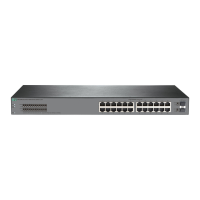183
Configuring IPv6 address assignment
About IPv6 address assignment
Use one of the following methods to configure IPv6 address assignment:
• Configure a static IPv6 address binding in an address pool.
If you bind a DUID and an IAID to an IPv6 address, the DUID and IAID in a request must match
those in the binding before the DHCPv6 server can assign the IPv6 address to the requesting
client. If you only bind a DUID to an IPv6 address, the DUID in a request must match the DUID
in the binding before the DHCPv6 server can assign the IPv6 address to the requesting client.
• Specify a subnet and address ranges in an address pool.
{ Non-temporary address assignment—The server selects addresses from the
non-temporary address range specified by the
address range command. If no
non-temporary address range is specified, the server selects addresses on the subnet
specified by the
network command.
{ Temporary address assignment—The server selects addresses from the temporary
address range specified by the
temporary address range command. If no temporary
address range is specified in the address pool, the DHCPv6 server cannot assign
temporary addresses to clients.
Restrictions and guidelines
• You can specify only one non-temporary address range and one temporary address range in an
address pool.
• The address ranges specified by the
address range and temporary address range
commands must be on the subnet specified by the network command. Otherwise, the
addresses are unassignable.
• Only one prefix pool can be applied to an address pool. You can apply a prefix pool that has not
been created to an address pool. The setting takes effect after the prefix pool is created.
• An IPv6 address can be bound to only one DHCPv6 client. You cannot modify bindings that
have been created. To change the binding for a DHCPv6 client, you must delete the existing
binding first.
• Only one subnet can be specified in an address pool. If you use the
network command
multiple times in a DHCPv6 address pool, the most recent configuration takes effect. If you use
this command to specify only new lifetimes, the settings do not affect existing leases. The IPv6
addresses assigned after the modification will use the new lifetimes.
Procedure
1. Enter system view.
system-view
2. (Optional.) Specify the IPv6 addresses excluded from dynamic assignment.
ipv6 dhcp server forbidden-address start-ipv6-address
[
end-ipv6-address ]
By default, all IPv6 addresses except for the DHCPv6 server's IP address in a DHCPv6 address
pool are assignable.
If the excluded IPv6 address is in a static binding, the address still can be assigned to the client.
3. Enter DHCPv6 address pool view.
ipv6 dhcp pool pool-name
4. Specify an IPv6 subnet for dynamic assignment.

